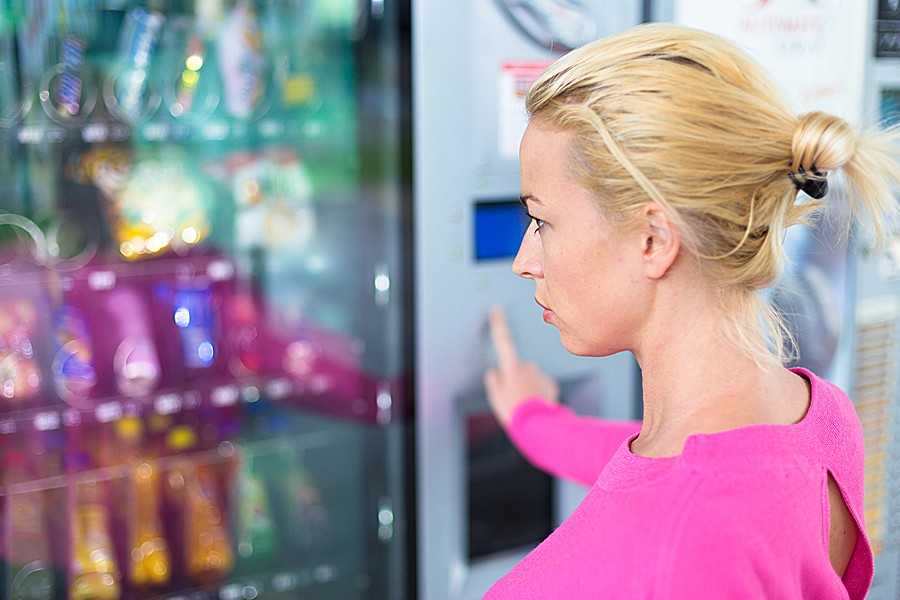The stomach grumbles. The light lunch let you down, or you're in need of an energy jolt. With the cafeteria closed and no more protein bars in your top desk drawer, thoughts turn to the vending machine down the hall or in the main floor lobby. Go ahead. Nobody will judge you. But before you start scrounging for change, Christine McKinney, a clinical dietitian at Johns Hopkins Bayview Medical Center, has some advice for how to approach the iconic food dispenser.
First, she says, ask yourself whether this trip is really necessary.
"The point of a vending machine is you're hungry and desperate," McKinney says. "So think: What are your other options? Can you walk to a grocery or convenience store that will offer you more varied nutritional options? Or, how hungry are you? Can you wait?"
McKinney says that a glass of water or cup of tea might be enough to satiate you until the next meal, or the hunger might pass. But when that snack urge is particularly strong, the vending machine will often win out.
But which one? Not all machines are created equal. Many public and private buildings still feature the standard packaged-food machines, stocked with chips, pretzels, cookies, candy bars, gum, granola bars, and snack cakes such as the enduring staple, the bear claw pastry. No shock, the majority of the processed-food offerings are laden with carbohydrates, added sugars, bad fats (trans or saturated), and sodium. A standard bag of potato chips, for example, contains 230 calories, 30 grams of carbs, and 15 grams of total fat. One popular candy bar has 240 calories, 27 grams of sugar, 4.5 grams of saturated fat, and 120 mg of sodium. That bear claw? Underneath all the icing and flaky goodness are some 480 calories, 23 grams of fat, 42 grams of carbs, and 22 grams of sugar. For some context, in a standard 2,350-calorie-per-day diet, the Food and Drug Administration recommends between 44 and 78 grams of fat (some 20 to 35 percent of calories for adults), 25 grams (six teaspoons) of sugar, 1,200 to 2,300 milligrams of sodium, and 225 to 325 grams of carbohydrates.
"So eat that one candy bar, and you're pretty much up to your daily limit with sugar," McKinney says. "Added sugars and saturated fats are not good. We don't need them."
McKinney suggests you overlook these offenders and consider something such as beef jerky or a bag of peanuts or trail mix, which, although high in sodium and fat, are overall low in sugars—typically 1 gram per serving—and provide beneficial fiber and protein that will leave you feeling somewhat full.
"If I have to hit a vending machine, my go-to choice is nuts," she says. Other low-guilt options are low-fat popcorn (120 calories and 2 grams of fiber) and a fig bar (190 calories, 2 grams of fiber, and it's real fruit).
Such foods, she says, might carry a "healthy option" sticker, although McKinney says the term "healthy" here is relative. Even the wholesome-looking granola bar features 29 grams of carbs, 11 grams of sugar, and 7 grams of fat. "Not perfect, but OK," she says.
McKinney warns that vending machine package size has changed in recent years, and many items could contain two or even three servings. Unless you plan to share, don't fall to the temptation. "When you are overly hungry, that small—and cheaper–portion doesn't seem like it will cut it. But it's the better choice," she says. "Save money and save some calories."
If it's an option, McKinney says to choose items from refrigerated vending machines, which offer perishable items such as hummus and pretzels, yogurt, cottage cheese, deli meat sandwiches, and even veggie packs.
"Some machines simply offer healthier choices as they're not just full of chips and candy," she says. "But you should have some say in the matter. If you don't see items you want, request that the vendors provide them. After all, they want your business, and they should be appealing to the buyer."
Even better, she says, is to plan ahead and have some healthy snack options on hand, such as a piece of fruit and some almonds, for when that snack attack hits. And stay hydrated throughout the day, and be mindful of true hunger feelings instead of cravings or boredom.
Currently, vendors are not required to show calorie counts or other nutritional information of vending machine items, although some do. McKinney says such a practice might deter people from selecting that frosted Pop-Tart. "It would be funny if a vending machine had all the packages backward so the nutrition facts panel was the only label showing," she says. "I wonder what our choices would be then."
Posted in Health+Well-Being








